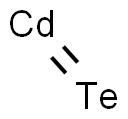LEAD TELLURIDE
- CAS NO.:1314-91-6
- Empirical Formula: PbTe
- Molecular Weight: 334.8
- MDL number: MFCD00016274
- EINECS: 215-247-1
- SAFETY DATA SHEET (SDS)
- Update Date: 2024-12-18 14:07:02

What is LEAD TELLURIDE?
Chemical properties
irregular chunks with metal lustre
Chemical properties
Lead telluride, PbTe, forms white cubic crystals, sp gr 8.16, and has a hardness of 3 on the Mohs’ scale. It is very slightly soluble in water, melts at 917 °C, and is prepared by melting lead and tellurium together. Lead telluride has semiconductive and photoconductive properties.
The Uses of LEAD TELLURIDE
Lead telluride is used in pyrometry, in heat-sensing instruments such as bolometers and infrared spectroscopes, and in thermoelectric elements to convert heat directly to electricity. Lead telluride is also used in catalysts for oxygen reduction in fuel cells, as cathodes in primary batteries with lithium anodes, in electrical contacts for vacuum switches, in lead-ion selective electrodes, in tunable lasers, and in thermistors.
The Uses of LEAD TELLURIDE
In photoconductor cells; in semiconductor research.
The Uses of LEAD TELLURIDE
In semiconductor research, photoconductor cellsLead(II) telluride is used as an infrared detector material. It is also used in spacecraft power applications. Further, it is used in infrared detection, imaging and in solar cells. In addition, it acts as a semiconductor and photoconductor in the form of single crystals.
General Description
This product has been enhanced for energy efficiency.
Structure and conformation
The space lattice of PbTe belongs to the cubic system, and its rock salt structure has a lattice constant of a=0.317 nm.
Properties of LEAD TELLURIDE
| Melting point: | 905 °C |
| Density | 8,164 g/cm3 |
| solubility | insoluble in H2O, acid solutions |
| form | Powder |
| Specific Gravity | 8.164 |
| color | Gray |
| Water Solubility | Insoluble in water. |
| Crystal Structure | Cubic, Halite Structure - Space Group Fm3m |
| Merck | 14,5422 |
| Exposure limits | ACGIH: TWA 0.05 mg/m3; TWA 0.1 mg/m3 NIOSH: IDLH 25 mg/m3; IDLH 100 mg/m3; TWA 0.1 mg/m3; TWA 0.050 mg/m3 |
| CAS DataBase Reference | 1314-91-6(CAS DataBase Reference) |
| EPA Substance Registry System | Lead(II) telluride (1314-91-6) |
Safety information for LEAD TELLURIDE
| Signal word | Danger |
| Pictogram(s) |
 Exclamation Mark Irritant GHS07  Health Hazard GHS08  Environment GHS09 |
| GHS Hazard Statements |
H351:Carcinogenicity H373:Specific target organ toxicity, repeated exposure H410:Hazardous to the aquatic environment, long-term hazard |
| Precautionary Statement Codes |
P202:Do not handle until all safety precautions have been read and understood. P260:Do not breathe dust/fume/gas/mist/vapours/spray. P273:Avoid release to the environment. P301+P312:IF SWALLOWED: call a POISON CENTER or doctor/physician IF you feel unwell. P308+P313:IF exposed or concerned: Get medical advice/attention. |
Computed Descriptors for LEAD TELLURIDE
New Products
Tert-butyl bis(2-chloroethyl)carbamate (S)-3-Aminobutanenitrile hydrochloride N-Boc-D-alaninol N-BOC-D/L-ALANINOL N-octanoyl benzotriazole 3-Morpholino-1-(4-nitrophenyl)-5,6-dihydropyridin- 2(1H)-one Furan-2,5-Dicarboxylic Acid Tropic acid Fmoc-Val-Cit-PAB DIETHYL AMINOMALONATE HYDROCHLORIDE 1,1’-CARBONYLDIIMIDAZOLE R-2-BENZYLOXY PROPIONIC ACID 1,1’-CARBONYLDI (1,2-4 TRIAZOLE) N-METHYL INDAZOLE-3-CARBOXYLIC ACID (2-Hydroxyphenyl)acetonitrile 4-Bromopyrazole 5-BROMO-2CYANO PYRIDINE 5-broMo-2-chloro-N-cyclopentylpyriMidin-4-aMine 2-(Cyanocyclohexyl)acetic acid 4-methoxy-3,5-dinitropyridine 2-aminopropyl benzoate hydrochloride 1-(4-(aminomethyl)benzyl)urea hydrochloride tert-butyl 4- (ureidomethyl)benzylcarbamate diethyl 2-(2-((tertbutoxycarbonyl)amino) ethyl)malonateRelated products of tetrahydrofuran








You may like
-
 Lead(II) telluride CAS 1314-91-6View Details
Lead(II) telluride CAS 1314-91-6View Details
1314-91-6 -
 Lead(II) telluride CAS 1314-91-6View Details
Lead(II) telluride CAS 1314-91-6View Details
1314-91-6 -
 Lead(II) telluride 99.998%+ CAS 1314-91-6View Details
Lead(II) telluride 99.998%+ CAS 1314-91-6View Details
1314-91-6 -
 Lead(II) telluride, 99.99% CAS 1314-91-6View Details
Lead(II) telluride, 99.99% CAS 1314-91-6View Details
1314-91-6 -
 Lead(II) telluride CAS 1314-91-6View Details
Lead(II) telluride CAS 1314-91-6View Details
1314-91-6 -
 14714-50-2 (2-Hydroxyphenyl)acetonitrile 98+View Details
14714-50-2 (2-Hydroxyphenyl)acetonitrile 98+View Details
14714-50-2 -
 118753-70-1 98+View Details
118753-70-1 98+View Details
118753-70-1 -
 733039-20-8 5-broMo-2-chloro-N-cyclopentylpyriMidin-4-aMine 98+View Details
733039-20-8 5-broMo-2-chloro-N-cyclopentylpyriMidin-4-aMine 98+View Details
733039-20-8